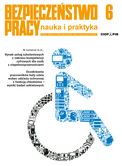Occupational stress of medical staff at psychiatric and addiction treatment wards – a review of research
Anna Łuczak, Łukasz Baka, Andrzej Najmiec
Occupational stress is an important problem in occupational safety and health, which recent research at EU-OSHA has shown. The effect of occupational stress is observed both in workers (e.g., psychological problems, depression, cardiovascular and musculoskeletal diseases, diabetes) and in enterprises (e.g., sick leave, employee turnover, decreased productivity). Most managers are aware of occupational stress in their companies; few companies have procedures for coping with it, though. This article presents a review of studies on the causes of occupational stress in medical staff at psychiatric and addiction treatment wards, who are in direct contact with patients. Those are considered to be special jobs, where exposure to stress is intrinsic.
Modelling occupational health and safety management systems with fuzzy cognitive maps and leading indicators: a theoretical approach
Anna Skład
In order to improve the effectiveness of an occupational safety and health management system (OSH MS), many enterprises use sets of leading and lagging performance indicators to measure individual processes in the system. Based on the value of indicators recorded in a given period, preventive measures are planned in the system. These measures are aimed at improving the processes in which the recorded indicators values did not reach their target values. This paper presents fuzzy cognitive maps, which enable an alternative application of indicators values. This method is based on the development of a system model consisting of a set of elements forming the system and the interconnections (influences) between these elements. Using a mathematical formula, it is possible to determine the values of the individual elements of the model and then forecast their future values. Unfavorable forecasts are the basis for taking preventive actions in a modeled system. By using fuzzy cognitive maps, it is possible to develop an OSH MS model. Individual processes and safety performance would be elements of the model. Leading and lagging indicator values would be used to determine the value of these elements. Forecasting on the basis of the model could significantly support the effectiveness of an OSH MS in an enterprise.
Health risks of a sales assistant at work
Elżbieta Łastowiecka-Moras
In Poland, 3.6 million people work in the trade sector, that is 26% of the total employment. Nearly two thirds of them are women. This sector also offers many jobs for young people who are entering the labour market, and for people with lower qualifications. A sales assistant is a service occupation, in which work load depends on the range of goods sold, duties, working conditions, and the size of the store. In large stores, tasks are divided between employees. In smaller ones, one worker must be able to perform all or most activities. Typical for sales assistants types of workload, such as manual materials handling, forced posture, repetitive motions and accompanying stress, cause many health problems, especially those of musculoskeletal, cardiovascular and nervous systems.
Analysis of hazards associated with injuries to the employee’s head during fall arrest
Krzysztof Baszczyński
A fall from a height is one of the most serious hazards faced by employees in the work environment. It is present mostly at workstations in such industries as construction, power engineering, mining, storage, etc. Using individual protective equipment against falls from a height is a basic method of protecting workers under such conditions. The choice of this method carries specific risks associated with the functioning of equipment during fall arrest. Hitting elements of the workstation during fall arrest associated with pendulum movement is a very serious threat. This paper presents conditions which trigger pendulum movement during fall arrest and the positions which a human equipped with a full body harness can assume then. Potential effects of the impact of the head against an obstacle during pendulum movement are discussed on the basis of the results of research with an anthropomorphic dummy. The article discusses methods of preventing swing movement and ways of mitigating the effects of collisions with obstacles within the workstation. It also presents the basic requirements for protective helmets intended for use with individual protection equipment against falls from a height.





























